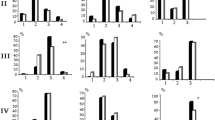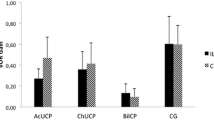Abstract
Lateral stabilographic response to galvanic labyrinth stimulation was investigated in healthy subjects in the standing position. Vestibulomotor response increased during forwards volitional body tilt as well as involuntary tilt occurring in response to stimulating (by vibration) the proprioceptors of the anterior tibial muscles. An illusion of the forward body tilt induced by stimulating (vibrating) the proprioceptors of the triceps surae muscles with the trunk fastened in a fixed position was accompanied by practically the same intensification of vestibulomotor response as during actual body movement. It was concluded that reinforcement of vestibulomotor response during volitional movements is brought about by the spatial perception system.
Similar content being viewed by others
Literature Cited
K. V. Baev, “Active selection of afferent information — the principle underlying peripheral correction of the operation of rhythmic movement generators,” Neirofiziologiya,16, No. 3, 343–353 (1984).
V. S. Gurfinkel' M. I. Lipshits, and K. E. Popov, “Investigating the erect posture control system by vibrational stimulation of muscle spindles,” Fiziol. Cheloveka,3, No. 3, 635–643 (1977).
K. E. Popov, B. N. Smetanin, V. S. Gurfinkel', et al., “Spatial perception and vestibulomotor response in man,” Neirofiziologiya,18, No. 6, 779–787 (1986).
B. N. Smetanin, V. Yu. Shlukov, and M. P. Kudinova, “Facilitatory action of volitional movement on vestibulomotor response in man,” Fiziol. Cheloveka,12, No. 1, 133–140 (1986).
G. Somjen, Sensory Coding in the Mamalian Nervous System, Prentice-Hall, Englewood Cliffs, NJ (1972).
R. I. Adkins, R. W. Morse, and A. L. Towe, “Control of somatosensory input by cerebral cortex,” Science,153, No. 3733, 1020–1022 (1966).
R. Bianconi and J. R. Meulen, “The response to vibration of the end organ of mammalian muscle spindles,” J. Neurophysiol.,26, No. 1, 177–190 (1963).
D. Burke, K.-E Hagbarth, L. Löfstedt, and B. G. Wallin, “The responses of human muscle spindle endings to vibration of non-contracting muscles,” J. Physiol.,261, No. 3, 673–693 (1976).
G. Eklund, “General features of vibration-induced effects on balance”, Uppsala J. Med. Sci.,77, No. 1, 112–124 (1972).
G. M. Goodwin, D. I. McCloskey, and P. B. C. Matthews, “The contribution of muscle afferents to kinaesthesia shown by vibration induced illusions of movement and by the effects of paralyzing joint afferents,” Brain,95, No. 4, 705–748 (1972).
S. Lund and C. Broberg, “Effects of different head positions on postural sway in man induced by a reproducible vestibular error signan,” Acta Physiol. Scand.,117, No. 2, 307–309 (1983).
Additional information
Institute for Research into Information Transmission, Academy of Sciences of the USSR, Moscow. Translated from Neirofiziologiya, Vol. 20, No. 2, pp. 250–255, March–April, 1988.
Rights and permissions
About this article
Cite this article
Smetanin, B.N., Popov, K.E., Gurfinkel, V.S. et al. Effect of movement and illusion of movement on human vestibulomotor response. Neurophysiology 20, 192–196 (1988). https://doi.org/10.1007/BF02141337
Received:
Issue Date:
DOI: https://doi.org/10.1007/BF02141337




